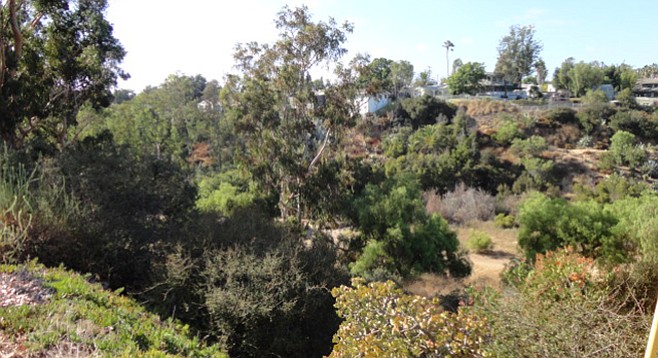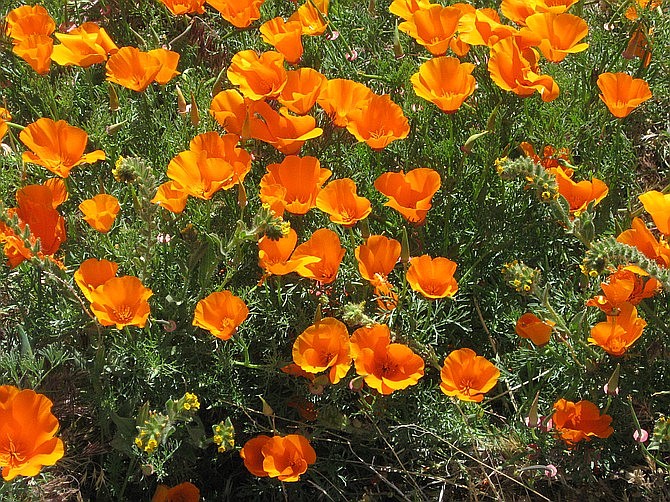 Facebook
Facebook
 X
X
 Instagram
Instagram
 TikTok
TikTok
 Youtube
Youtube

The Pleasantly Pungent Odor of sage is filling the air wherever native vegetation grows on the county’s coastal and lower-foothill slopes. Most common are the black sage, with tight clusters of small, white flowers; the grayish-leaved white sage; purple-blossomed, sweet-smelling Cleveland sage; and California sagebrush, characterized by soft, needle-like leaves.
Ornamental Peach Trees, with radiant white and pink blossoms, are lighting up the manicured landscape around Sixth Avenue and Laurel Street in Balboa Park. These and other “stone fruit” trees, with and without edible fruits, belong to the genus Prunus. Several native Prunus species contribute to San Diego County’s natural vegetation as well — among them, hollyleaf cherry, choke cherry, desert almond, and desert apricot. The desert apricot, now in full bloom on the rocky hillsides of the AnzaBorrego Desert, attracts swarms of bees with its sweet-smelling nectar.
The Coastal Wildflower Bloom will likely continue into April. One of the best spots for viewing the greatest variety of flowers is Torrey Pines State Reserve. San Onofre State Beach, just north of Camp Pendleton, should have acres and acres of monkeyflower, with a halfdozen different shades, blooming on the coastal bluffs.

On grassy hillsides in Los Peñasquitos Canyon Preserve and in Mission Trails Regional Park (especially behind the Old Mission Dam), you may find carpets of California poppies, purple nightshade, pinkish owl’s clover, blue-colored lupine, and scattered splashes of color due to a dozen or more other species of wildflowers. North County residents should check out the huge Daley Ranch preserve in northeast Escondido. Its rolling hillsides and grassy meadows should sport a fantastic display of wildflowers by late March.
The Big Dipper is high in the northeast and beginning to tip left. Look left of its center, by about three fists at arm's length, for Polaris in the dim Little Dipper. Other than Polaris, all you may see of the Little Dipper through light pollution are the two stars forming the outer edge of its bowl: Kochab (similar to Polaris in brightness) and below it, fainter Pherkad. Find these two "Guardians of the Pole" to Polaris's lower right by about a fist and a half at arm's length.
The above comes from the Outdoors listings in the Reader compiled by Jerry Schad, author of Afoot & Afield in San Diego County. Schad died in 2011. Planet information from SkyandTelescope.org.


The Pleasantly Pungent Odor of sage is filling the air wherever native vegetation grows on the county’s coastal and lower-foothill slopes. Most common are the black sage, with tight clusters of small, white flowers; the grayish-leaved white sage; purple-blossomed, sweet-smelling Cleveland sage; and California sagebrush, characterized by soft, needle-like leaves.
Ornamental Peach Trees, with radiant white and pink blossoms, are lighting up the manicured landscape around Sixth Avenue and Laurel Street in Balboa Park. These and other “stone fruit” trees, with and without edible fruits, belong to the genus Prunus. Several native Prunus species contribute to San Diego County’s natural vegetation as well — among them, hollyleaf cherry, choke cherry, desert almond, and desert apricot. The desert apricot, now in full bloom on the rocky hillsides of the AnzaBorrego Desert, attracts swarms of bees with its sweet-smelling nectar.
The Coastal Wildflower Bloom will likely continue into April. One of the best spots for viewing the greatest variety of flowers is Torrey Pines State Reserve. San Onofre State Beach, just north of Camp Pendleton, should have acres and acres of monkeyflower, with a halfdozen different shades, blooming on the coastal bluffs.

On grassy hillsides in Los Peñasquitos Canyon Preserve and in Mission Trails Regional Park (especially behind the Old Mission Dam), you may find carpets of California poppies, purple nightshade, pinkish owl’s clover, blue-colored lupine, and scattered splashes of color due to a dozen or more other species of wildflowers. North County residents should check out the huge Daley Ranch preserve in northeast Escondido. Its rolling hillsides and grassy meadows should sport a fantastic display of wildflowers by late March.
The Big Dipper is high in the northeast and beginning to tip left. Look left of its center, by about three fists at arm's length, for Polaris in the dim Little Dipper. Other than Polaris, all you may see of the Little Dipper through light pollution are the two stars forming the outer edge of its bowl: Kochab (similar to Polaris in brightness) and below it, fainter Pherkad. Find these two "Guardians of the Pole" to Polaris's lower right by about a fist and a half at arm's length.
The above comes from the Outdoors listings in the Reader compiled by Jerry Schad, author of Afoot & Afield in San Diego County. Schad died in 2011. Planet information from SkyandTelescope.org.
Comments